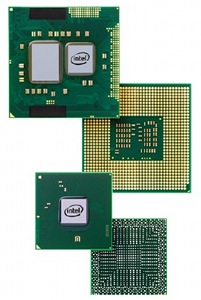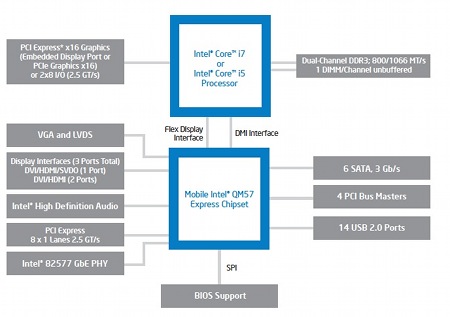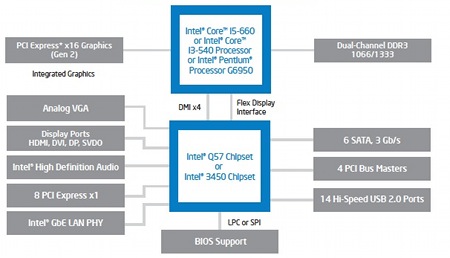Intel’s chip blitz includes 12 embedded CPUs
Jan 7, 2010 — by LinuxDevices Staff — from the LinuxDevices Archive — 11 viewsIntel used an early-morning conference at today's Consumer Electronics Show to roll out 27 new processors, including 12 specifically aimed at embedded devices. Additions to the chipmaker's Core i3, i5, i7, and Xeon families, the CPUs have two or four cores, include on-chip graphics, and incorporate “Turbo Boost” technology, according to the company.
 Intel's announcement included 27 processors overall, including Core i3, i5, i7, and Xeon models. Features and performance generally increase with the size of the i number: According to Intel officials, the Core i5 has twice the performance of the Core 2 Duo CPU it will supplant.
Intel's announcement included 27 processors overall, including Core i3, i5, i7, and Xeon models. Features and performance generally increase with the size of the i number: According to Intel officials, the Core i5 has twice the performance of the Core 2 Duo CPU it will supplant.
Intel says all its new Core processors are manufactured using the company's 32nm process, which includes second-generation high-k metal gate transistors. (The chipmaker invested $7 billion in the 32nm process in early 2009, writes Nicholas Kolakowski in a story for our sister publication eWEEK.com.)
According to the chipmaker, Core i3, i5, and i7 all include hyperthreading technology that "emables smart multi-tasking." Meanwhile, Core i5 and i7 models also feature "Turbo Boost Technology," whereby clock speed can be bumped up temporarily in response to work load.
Intel says that while the new Core processors may, of course, be used with separate discrete graphics chips, they are also "the first to integrate graphics into mainstream PC processors." The onboard graphics are said to be adequate for "mainstream and casual 3-D gaming" and support smooth HD video playback. All new CPUs employ Intel's 5 Series chipset, touted as "the company's first single-chip chipset solution."
12 new embedded parts
Signaling a greater-than-ever interest in embedded devices, Sean Maloney, EVP and GM of Intel's architecture group, said embedded is now more than a billion dollar market for Intel. "We have something in the range of 200 different designs using our technology for embedded stuff," he is quoted by Kolakowski as adding.
Maloney continued, "We're seeing a lot of action going on in retail; some 98 percent of ATMs are based around existing Core or Pentium technologies, and we're seeing a surge of people wanting to put facial recognition in ATMs."
Responding to such demand, Intel announced 12 new embedded-specific CPUs in the Core i3, Core i5, Core i7, and Xeon families, as listed in the table below. Power consumption ranges from a low of 18 Watts for the dual-core, 1.06GHz i7-620UE, to a high of 95 Watts for the quad-core, 2.8GHz Core i7-860, according to the chipmaker.
|
Processor |
Base clock speed (GHz) |
Turbo frequency (GHz) |
Cores / threads |
TDP |
ECC |
Pricing |
|---|---|---|---|---|---|---|
|
Core i7-620M |
2.66 |
Up to 3.33 GHz |
2/4 |
35W |
No |
$332 |
|
Core i7-610E |
2.53 |
Up to 3.20 GHz |
2/4 |
35W |
Yes |
$332 |
|
Core i7-620LE |
2.0 |
Up to 2.80 GHz |
2/4 |
25W |
Yes |
$300 |
|
Core i7-620UE |
1.06 |
Up to 2.13 GHz |
2/4 |
18W |
Yes |
$278 |
|
Core i5-520M |
2.4 |
Up to 2.93 GHz |
2/4 |
35W |
No |
$225 |
|
Core i5-520E |
2.4 |
Up to 2.93 GHz |
2/4 |
35W |
Yes |
$225 |
|
Core i5-660 |
3.33 |
Up to 3.60 GHz |
2/4 |
73W |
Yes |
$196 |
|
Core i3-540 |
3.06 |
n/a |
2/4 |
73W |
Yes |
$133 |
|
Core i7-860 |
2.8 |
Up to 3.46 GHz |
4/8 |
95W |
No |
$284 |
|
Core i5-750 |
2.66 |
Up to 3.20 GHz |
4/4 |
95W |
No |
$196 |
|
Xeon X3450 |
2.66 |
Up to 3.20 GHz |
4/8 |
95W |
Yes |
$241 |
|
Xeon X3430 |
2.4 |
Up to 2.80 GHz |
4/4 |
95W |
Yes |
$189 |
Intel's new embedded CPUs
Source: Intel
All of the embedded CPUs but one include Intel's Turbo Boost technology, capable of selectively enhancing performance. The Core i7-860, for example, can speed up from its base 2.8GHz clock speed to 3.46GHz. (Turbo Boost aside, we have to declare that Intel's Core i3, i5, i7, and Xeon branding provides little or no help when it comes to conveying the relative performance offered by these different processors.)
Intel says its new Core i5 and i7 embedded processors, previously codenamed "Arrandale," are designed to work with the QM57 Express "notebook class" chipset (below), for an overall two-chip solution that, in the case of most, can support ECC (error correcting code) memory. TDP options range from 18 Watts to 35 Watts, the chipmaker adds.

Intel's QM57 Express chipset
(Click to enlarge)
The Core i5-660 and Core i3-540 processors, previously codenamed "Clarksdale," are designed to work either with the Q57 Express ("desktop class") or 3450 chipsets (below), with 75-Watt processor TDPs. The Core i7-860 and i5-750 (previously, "Lynnfield") both have quad cores and 95-Watt TDPs, and work with the Q57 Express chipset.

Intel's Q57 Express and 3450 chipsets
(Click to enlarge)
Finally, Intel's new Xeon X3450 and X3430 offer quad-cores, 95-Watt TDPs, and are designed to work with the 3450 chipset. Despite what might have been implied by the chipmaker's overall announcement, the new Xeons are 45nm parts, not 32nm, and are similar to the "Jasper Forest" parts announced last fall.
Availability
More information on Intel's new embedded CPUs may be found on the manufacturer's website, here.
Intel CEO Paul Otellini will deliver a CES keynote this afternoon starting at 4:30 p.m. PT. A live webcast of the keynote will be available on the Intel website, here, according to the chipmaker.
Additional information on Intel's overall processor launch may be found in Nicholas Kolakowski's eWEEK story, here.
This article was originally published on LinuxDevices.com and has been donated to the open source community by QuinStreet Inc. Please visit LinuxToday.com for up-to-date news and articles about Linux and open source.